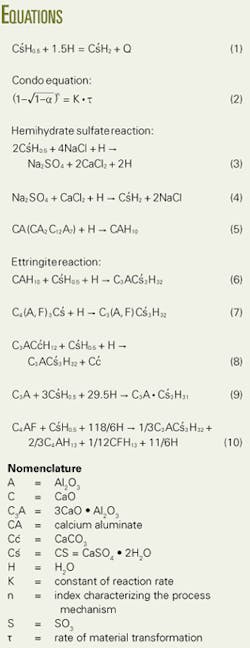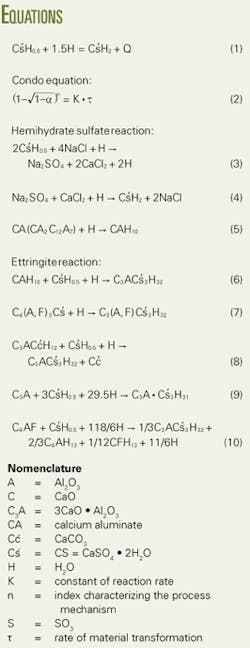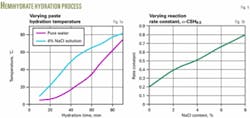Field tests of arctic cements in the Bovanenkovo gas-condensate field on the Yamal peninsula in northern Russia will benefit an upcoming drilling program.
Oil and gas fields of Russia are being developed in the harsh climatic and geological conditions of the extreme north and Arctic seas shelf.
The complicated geological conditions include permafrost, intrapermafrost water, upper gas flowing horizons (100-150 m), and soft rocks with low-fracture gradients (0.0150-0.0160 MPa/m).
Low temperatures can cause certain energetic and kinetic deviations during the hydration of hardening cement in contrast to hydration at normal temperatures. Decreasing temperature retards hydration of clinker minerals. When passing below 0° C., hydration is sharply retarded and cement lattice structure cannot properly form due to propping action of ice.
At the same time, for exothermic reactions, characterized by intensive heat release, lowering the temperature increases formation of a number of compounds. This mechanism was the basis to design materials hardening at temperatures below freezing, including those based on hemihydrate gypsum1 and a mixture of periclase, MgO, with monopotassic phosphate, KH2PO4 (OGJ, May 16, 2005, pp. 48-52; OGJ, May 9, 2005, pp. 53-55).
The aim of this work was to produce a water resistant, cement-gypsum mixture with no free water.
Arctic cement synthesis
Hydration of α-hemihydrate gypsum is an exothermic process. A change in temperature of gypsum test corresponds to a certain amount of hemihydrate gypsum reacting with water (Equation 1 in the equation box).
The constant reaction rate of α-hemihydrate dissolution (K1) and process of double hydrate gypsum (K2) crystallization was determined by the Condo equation (Equation 2).
According to test results, K1 = 0.25 and K2 = 0.05. These data indicate that crystallization is a limiting stage of the hardening process. Correspondingly, by adding different chemicals to the cementing agent, one can regulate the hydration and hardening processes. For this purpose, sodium chloride (a freezing point depressant) and softeners (water-cement ratio depressants) are of the most interest.
Equations 3 and 4 show the reactions for hemihydrate sulfate interaction. The reactions repeat until the initial hemihydrate is consumed.
Comparing temperature curves of the hemihydrate hydration process in water and in sodium chloride solutions at different concentrations demonstrates the accelerating action of sodium chloride on the formation process of α-CSH0.5 (Fig. 1a). The constant of the reaction rate of hemihydrate dissolution in a water solution of sodium chloride (K1) is four times higher than hemihydrate hydration in water (Fig.1b).
The formation of sodium sulfate during the exchange reaction enhances solution saturation and gypsum crystallization. Many companies use these properties of gypsum when preparing gypsum-cement mixtures to cement arctic wells.1 According to physical-chemical analysis data, gypsum hemihydrate amounts to 50-60 mass %.4 Useful properties of gypsum cements are:
- Setting and hardening ability at temperatures to -9° C.
- Independent setting times vs. temperature (+20° C. to -5° C.).
These mixtures, however, increase free water up to 5% and have a low water-resistance coefficient (Kw <0.8) owing to gypsum matrix dissolution in water-saturated beds. The mass of the cement samples in water may decrease as much as 50% in 1 year.
In order to eliminate these disadvantages, we propose three ways to replace part of the gypsum with components in whose presence hydrosilicate phases (C-S-H) and ettringite expanded phase (C3ACs´3H32) will predominantly form. These network-forming elements of water-resistant cement stone are thermodynamically stable at lower temperatures.
The first way involves adding alumina cement to the gypsum cement mixture (Equations 5 and 6).
The second way involves adding ground sulfated clinker-C4(A,F)C3s´-to a gypsum cement mixture (Equation 7).
The third way to improve the quality of the mixture is to replace part of the gypsum hemihydrate with nonhygroscopic calcium hydrocarboaluminate (a coproduct of integrated nepheline processing into alumina) and first-class coproducts (Equation 8).
Experiment
Cement for the arctic wells was prepared using the first procedure by mixing ground Portland cement clinker, aluminous slag, and gypsum hemihydrate. To optimize the compositions, we investigated the structural formation of mixtures with a minimal water/cement (W/C) factor to provide an adequate period for pumping mud into the hole annular space. We decreased the W/C factor by adding plasticizing agents (S-3, LSTM, HG), which are also grinding intensifiers.
Calculation of the required amount of gypsum hemihydrate was performed based on Equations 9 and 10.
As the calculation indicates, it is sufficient to add 20-25 mass % of gypsum hemihydrate to Portland cement in order to achieve the purpose. As a whole, the hemihydrate in the mixture was 2-2.5 times less than that in the known gypsum cement mixtures.
We prepared the samples using a standardized procedure and subsequently tested them for free-water content. Next, the samples were placed in a climate cell at 0° C. and -7° C. for 1, 2, 7, and 28 days. After the hardening time, the samples were tested for bending strength and water resistance. The water resistance coefficient was determined using the ratio between compressive strength of the samples hardening in an aqueous medium and the compressive strength of the samples hardening under air-dried conditions at 0° C. ±2° C. After a set time, hydration stopped and the samples were examined using physical-chemical analysis.
Results of X-ray phase analysis of the specimens’ normal hardening (at 20º C.) showed that over time, the intensity of lines, characteristic of clinker materials and hemihydrate, decreases after only 1 day of hardening. The X-ray pictures clearly show lines belonging to ettringite (d = 9.8; 5.65; 3.92Å), the intensity of which increases with hydration time. SEM photomicrographs show the needle prisms of ettringite in a mass of hydrosilicates (Fig. 2).
By the third day, the intensity of the ettringite lines stabilizes, with the simultaneous appearance of diffraction lines of double-hydrate gypsum (d = 7.56; 4.27; 3.06Å). The intensity of the double-hydrate gypsum increases by Day 7 and changes insignificantly after that.
The X-ray picture shows distinct lines of calcium hydroxide (d = 4.92; 2.11Å). Specimens hardening at temperatures below freezing have distinct lines of the same formations. The intensity of the diffraction maximums of ettringite changes insignificantly in comparison with their intensity specimens hardened at temperatures above freezing. The maximum value of the calcium hydroxide diffraction line (d = 4.90Å) decreases somewhat, compared with its intensity under normal hardening conditions.
At lower temperatures, lime has higher solubility; in the presence of both lime and hemihydrate (the hydration of which gives significant amount of heat), ettringite quickly forms. Diffraction maximum values (d = 7.1; 3.64; 3.24Å) characteristic of calcium hydrosilicate are also fixed on X-ray pictures of the specimens.
When sodium chloride comprises 2-8 mass % of the mixture, it accelerates the hydration process. Derivatography shows the results of the specimens’ mass loss in the study. The amount of bound water during the hydration process is 25% at 20º C.; 25.7% at 0º C., and 26% at -7º C. Water adsorption by the multimolecular layer explains the increased amount of bound water at lower temperatures.3
Among the hydration products, is a composition characteristic of Portland cement; calcium hydrochloraluminate (C3A · 3CaCl2 · 30H) is observed with d = 7.9Å and endoeffect in the temperature interval 350-400º C. The cement bending strength increases during the hardening time (Table 1). The amount of free water in all cases is zero, and the water resistance factor ranges from 0.97 to 1.0.
Field tests
Commercial batches of arctic cement (“Arctcement”) were used at the Bovanenkovo gas-condensate field on the Yamal peninsula in 1996-97 for cementing 426-mm diameter conductors at a depth of 150 m, and 324-mm diameter conductors at a depth of 450 m. Cementing was carried out by raising cement to the wellhead. According to acoustic cement-bond logging, the quality of cementing was good.
Results
Replacing part of the hemihydrate gypsum in the gypsum-cement mixture by aluminate cement with a complex additive (a plasticizing agent such as sodium chloride) results in cement that meets the requirements for cementing arctic wells:
- The ability to set in the casing string-borehole annulus at temperatures below freezing without having to heat liquid for mixing cement and displacing fluid.4
- No free water, which prevents casing string collapse in case of fluid backfreezing.
- Enhanced water resistance and, as a result, enhanced durability of cement insulation in a geologically complex well section.
Future
After a 10-year drilling hiatus, Gazprom is about to begin a 2-3-year development drilling program on the Yamal peninsula (Bovanenkovo gas-condensate field). The company intends to drill more than 150 wells and will use arctic cements in the well construction, including 324-mm and 245-mm diameter conductors. The field testing described in this article helped delineate cements most suitable for the extremely difficult conditions on the peninsula.
References
- Cunningham, V.C., Ferenbach, I.R., and Maier, L.F., “Arctic Cements and Cementing,” J. Petroleum Technology, 1972, No. 4, pp. 49-55.
- Klyusov, A.A., “Study of Class G cement and permafrost mixture properties according to the national standard,” J. Neftyanoye khozyaistvo, USSR, No. 6, 1979, pp. 31-34.
- Klyusov, A.A., Lepnev, E.N., Pestov, A.A., “3CaO·SiO2 hydration in electrolite solutions under decreased temperatures,” J. Applied Chemistry, Academy of Sciences of USSR, No. 11, 1974, pp. 2,436-2,437.
- American Petroleum Institute, Spec. 10: Materials and Testing for Well Cements. Appendix K: Arctic Cementing Testing Procedure, 1990, p. 89.
The authors
Anatoly A. Klyusov was head of well cementing and completion laboratory in the Research Institute of Natural Gases and Gas Technologies (Vniigaz Ltd.), part of Gazprom Co. He worked in Tyumen (Western Siberia) from 1968-94 as a head of the Plugging Material Laboratory of the Research Institute of Gas and a head of chair in the Architectural-Building Academy. Klyusov graduated from Leningrad Technological Institute as a cement technology engineer (1963). He earned a PhD (1973) and DSc (1993) from Mendeleev Chemistry Technology Institute in Moscow. Klyusov has received the Russian State Prize and been named honor inventor of Russia. He was a fellow of the Royal Chemistry Society (Great Britain) and SPE. Editor’s note: Klyusov passed away while this article was being processed.
Yuri R. Krivoborodov (ykriv @rctu.ru) is a professor in the cement department at Mendeleyev University of Chemical Technology, Moscow. He received his education from Mendeleyev University of Chemical Technology (engineer-chemist, 1978, PhD in 1983, DSc in 2002). His teaching and research areas are in chemistry and oilwell technology and other special cements.
Vsevolod A. Klyusov (Vaklusov @burgaz.gazprom.ru) is a senior specialist in the drilling department of Burgaz Drilling Co., Gazprom Co. He graduated in 1998 from the Tyumen Oil and Gas University. Thereafter, he took postgraduate courses at Tyumen Architectural-Building Academy and earned a PhD (2000) in drilling from Tyumen Oil and Gas University. He has authored more than 40 scientific articles and holds 12 patents in the Russian Federation. Klyusov is a member of the SPE.







